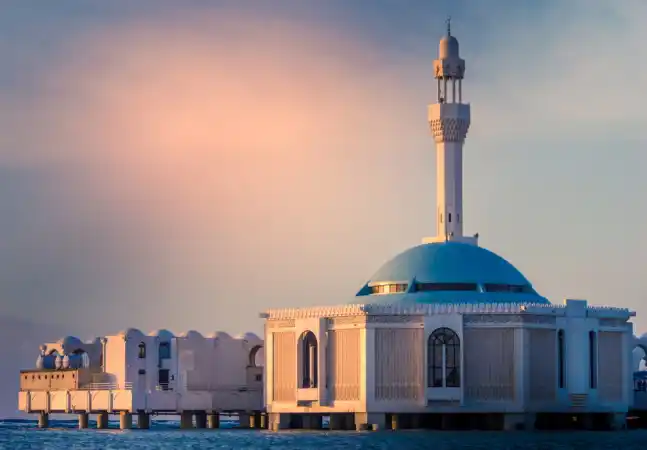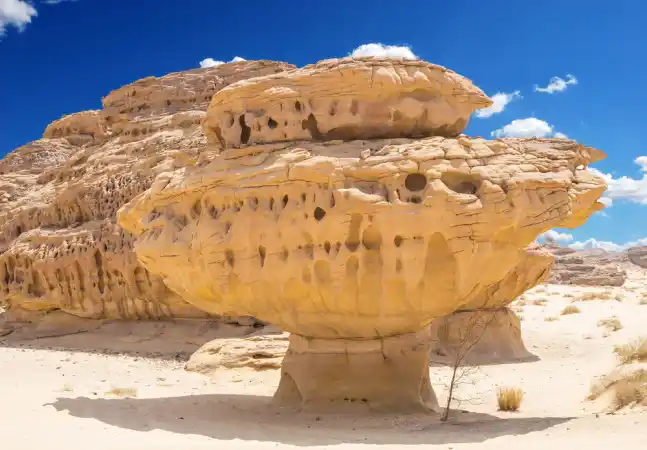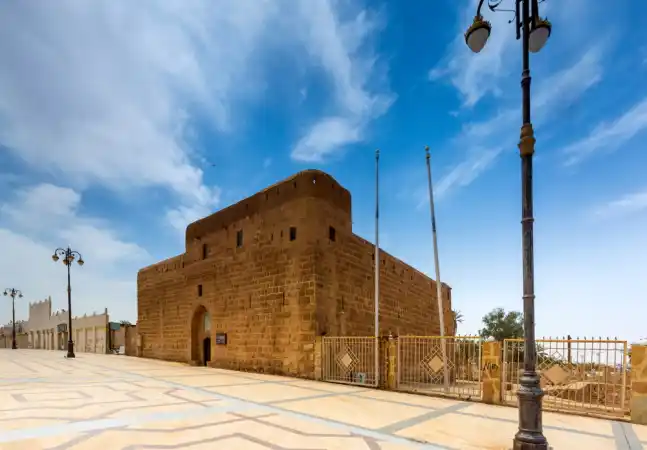The "Grand Tour of Saudi History: A Journey Back in Time" invites you to explore the rich and diverse heritage of Saudi Arabia through a meticulously crafted historical adventure. This immersive journey takes you from the ancient rock art of Al-Ula and the historic sites of Diriyah to the bustling modernity of Riyadh and the cultural treasures of Jeddah. Each destination along this tour reveals a different chapter of Saudi Arabia's past, offering a profound insight into the Kingdom's evolution from its earliest civilizations to its current prominence. As you traverse through time, you'll uncover the stories, landmarks, and artifacts that have shaped Saudi Arabia's unique cultural and historical landscape.
Day 1: Riyadh
Arrive Riyadh and transfer to Four Points by Sheraton Hotel (4*). Overnight at the hotel.
Day 2: Riyadh
Morning visit historical city of Diriyyah, Musmak Fort and DiraSouq. Lunch at local restaurant. Afternoon visit National Museum followed by visit to Kingdom Tower Bridge for a panoramic view of Riyadh. Dinner and Overnight at the hotel.
The old city of Dirriyyah is located about 20km from the main city center of Riyadh. It is one of the most important archaeological sites from where the history of Saudi Dynasty begins. It is situated in the eastern part of the so-called Najd area in the valley known as Wadi Hanifa. The meaning of Najid is the high plateau, which forms the central part of Saudi Arabia.It is recorded by the chronicles that one of the person known as Ibn Dir, who was also the chief of al-Dir clan of Duru, which was belonging to Bani Hanifa tribe, was ruling this area. He had a vast fertile land in the valley, which he was not able to utilize completely due to lack of thin population of his clan. Therefore, he invited another clan of the same Banu Hanifa tribe to settle down on the fertile area of the Hanifa valley. Therefore, the clan named Murdah comes under the leadership of Mani Al-Muraydi in 1446 A.D in Wadi Hanifa. IbnDir gave land for the cultivation to the clan in the Wadi Hanifa and the clan settled down. They were the ancestors of the Al-Saud family who established their first rule at Dirriyya. The Musmak Fort is one of the most important monuments in Saudi Arabia from where the modern Saudi History begins. It is an important historic landmark in the city of Riyadh. This palace was built during the reign of Abdullah bin Rashid in the year 1895 A.D. The reason for building this historic palace was to serve as military garrison for the Abdullah bin Rashid army who was operating under a Governor in Riyadh from the Hail. His Majesty King Abdulaziz on 15th January 1902 captured the fort.
The National Museum, which opened in Riyadh in 1999 to celebrate the centenary of Saudi unification, was the result of an international design competition. The primary custodian of the Saudi national heritage and culture, the Museum is a place of learning and discovery, designed to sing out with quiet excitement and inspiration, to kindle pride in the Arab heritage and reverence for Islam. This national Landmark is composed of eight galleries telling the complete story of Arabian History from the creation of the universe to our modern era.
Day 3:Riyadh – Al Ula
Breakfast at the hotel. Transfer to the airport for your flight SV 1574 (0910-1055) to Al Ula. Arrive and transfer to tent village. Lunch at the local restaurant. Visit old houses. Dinner and overnight at Tent Village.
Day 4:Al Ula / Madain Saleh
Breakfast at the tent village. Today proceed for a full day excursion to magnificent Nabatean sites of Madain Saleh which includes Qasr Bint, Diwan, Qasr Farid etc. Lunch at local restaurant. Afternoon visit underground city, Lihyan etc. Dinner and overnight at tent village.
Wadi Al Ula, gateway to Madain Saleh is known for its Lion of the Lihyanites-predecessors of the Natateans (100 to 500 BC). Madain Saleh is the prime tourist attraction of the Kingdom. It was known as “Al Hijr” in the ancient times and served as a stopover on a very prosperous trade route. The cities lie on 9 square Km in an area of isolation about 845 Km from Jeddah in the northwestern part of Saudi Arabia between Tabouk and Madinah. Qasr Bint means “Palace of Daughters”. This is the largest tomb at Madain Saleh sites. It is raised above ground level. An inscription plaque is indicated on the door way.
There are many archaeological inscription on the sand rocks which are considered by archaeologists to be Lihyanite script on top of the Athleb Mountain. These inscriptions dateback to the 3rd–2nd century.
Day 5:Al Ula – Tabuk
Breakfast at tent village. Drive to Tabuk. Arrive Tabuk and transfer to Swiss Inn. Lunch at the hotel. Afternoon visit Tabuk Fort, Nabawi Mosque and Hijaz Railways (all from outside). Dinner and overnight at the hotel.
The Tabuk Fort dates back to about 3500 BCE and has been restored many times; the last was in 1062 AH (1652 CE). It was one of the several forts and stations built along the Syrian pilgrimage route to welcome pilgrims. Prophet Mosque is also known as the Repentance Mosque. It was originally built with mud and roofed with palm trunk trees. It was restored during the year 1062 AH (1652 CE).
Day 6: Tabuk – Hisma Valley – Tabuk
Breakfast at the hotel. Proceed for a full day excursion to Hisma Valley. Picnic Lunch. Continue your excursion. Dinner and Overnight at the hotel. Hisma Valley in Tabuk is home of hundreds of unique and beautiful rock formations as well as ancient rock art and hundreds of Arabic inscriptions dating back to the first decades of Islam.
Day 7:Tabuk – Jeddah
Breakfast at the hotel. Transfer to the airport for your flight SV 1538 (1140-1310) to Jeddah. Arrive Jeddah and transfer to Prime Al HamraHotel. Afternoon proceed for open museum. Dinner and overnight at the hotel.
You will see a lot of sculptures in Jeddah. Some of the most prominent sculptures have been exposed to the natural elements, strong winds and the salt of the sea and had suffered extensive damage over the last few decades. Therefore, it was decided to not only restore them to their former glory but also to increase their prominence by creating an open-air museum.
Day 8: Jeddah
Breakfast at the hotel. Visit Hijaz Construction's old houses, Nasif House,Bughdadi House. Jamjom House, Noor Wali House, Matboli House, Almaemar Mosque, Old Gold Market in Bagel Street, Ain Farel Yuser, Shafei & Ukash Mosque. Check-out from the hotel. Lunch at local restaurant. Afternoon Visit Al Rahmah Mosque and Jeddah Aquarium. Visit Open Jeddah Museum and King Fahd Fountain. Dinner at Ramesses Restaurant in front of King Fahd Fountain. Transfer to the airport for your departure flight.
Historical Houses were constructed from coral and reinforced with wood so that beams criss-cross the interior walls. Wooden balconies and casement windows are a special feature of Jeddah's style, with elaborate casements decorating the facades of the old houses - normally there is a small balcony fronting every window. Doors and windows shutters are intricately carved. Some are painted and some remain simply wood with varnish.
The Nasif House was built during the 1850s by the well-known Nasif Family, one of the most influential trading families in thelong history of Jeddah. In the 19th and early 20th centuries thehouse was one of the most important building in Jeddah. It was here that King Abdul Aziz spent his first night in Jeddah, as the guest of Mohammed Nasif, after he lead his victorious armyinto the capital of the Western Province. The Municipality of Jeddahrecognized the architectural and historic value of the house and in1964 it was converted into a museum and put under Governmentcare.
The cornische of Jeddah is one of the most important archievementsof the city and is a major attraction for visitors to Jeddah. As Jeddah's Red Sea coast extends for more than 80 km, the Munici-pality has made use of this long expanse of waterfront and turnedit into place of fresh air for the city. And in the evening back to home.











